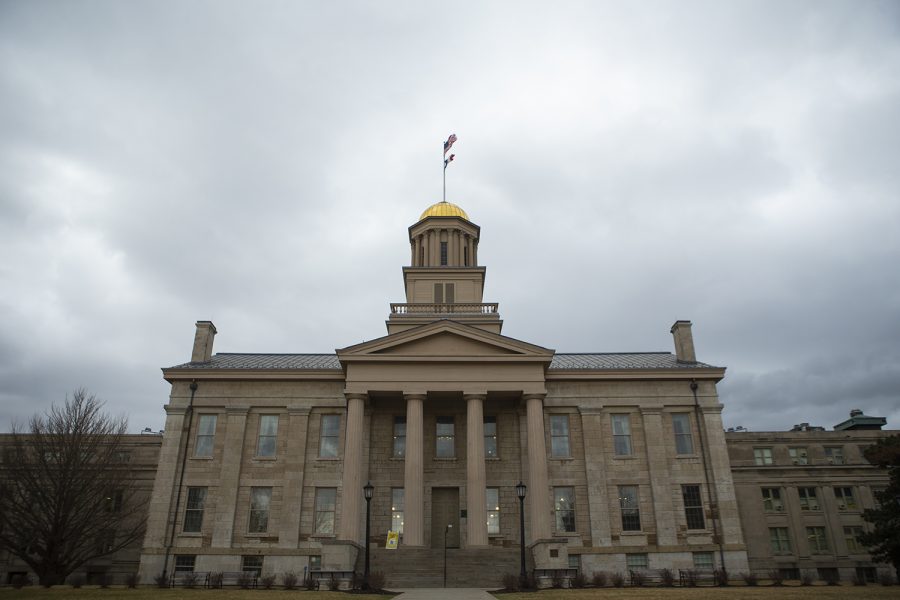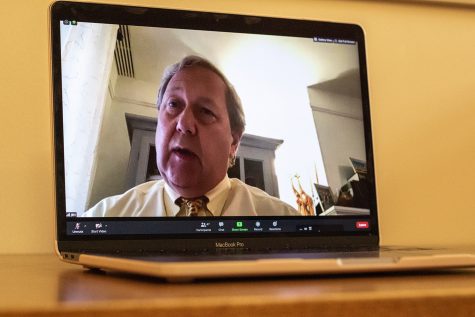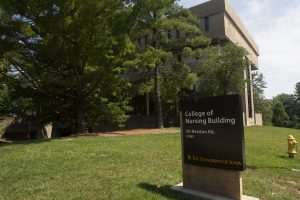University of Iowa to begin testing any students, Harreld says, as Johnson County coronavirus cases continue to climb
As Johnson County has reported a rising number in coronavirus cases within the past week, University of Iowa President Bruce Harreld told student government leaders on Tuesday that testing will soon become available to UI students.
The Old Capitol is seen on Thursday, March 12, 2020.
August 25, 2020
University of Iowa President Bruce Harreld told student government leaders on Tuesday that testing options would be available to students soon, but didn’t specify any timeline, while cases ramp up in Johnson County.
After senators discussed the lack of testing for students who are not experiencing symptoms of COVID-19, Harreld said that the UI is trying to test as many students as possible while saving testing materials.
“Anyone who is symptomatic will get tested, period,” he said. “We decided to focus on that because [we are] trying to preserve our testing [materials]. Whether we like it or not, we still have limited reagents and capacity for testing… But anybody who needs a test will get a test.”
Harreld said he hopes the university will soon be able to test anyone who wants a test, even if they do not have symptoms of the virus.
UI Dean of Students Angie Reams said the university is working on getting a testing location on the east side of campus as well as opening QuickCare for COVID-19 testing.
“We are going to start expanding some testing to the QuickCare that is in the Old Capitol Mall, as well as try to put up an east side testing location that is more accessible to the east side residence halls,” Reams said. “We hope more information will be out tomorrow [Wednesday], but we are waiting for updates from the [UI] hospital. We do plan to communicate that [plan] to campus soon.”
This past week, 107 UI students and four UI faculty self-reported they tested positive for the virus. Monday’s UI COVID-19 campus update also revealed that 19 residence hall students are in quarantine and eight residence hall students in isolation, approximately one week after the first move-in date for the residence halls.
Since mid-day on Monday, UI Student Health had conducted 226 COVID-19 tests, 5,723 video and phone visits, and 2,259 in-person visits since the end of March, according to Associate Director of Operations of UI Student Health Todd Patterson.
With a high influx of COVID-19 cases in Johnson County, UI Student Health said more testing options are becoming available and are accommodating to the numbers.
“We have extended our hours this week, so that we can help more students. Our Nurseline is also taking calls through 8 PM the rest of this week, and will have hours this weekend as well, due to the higher volume of students with questions and concerns,” Assistant Director for Quality Improvement and Strategic Communications Lisa James said.
On Aug. 21, Johnson County Public Health confirmed 2,344 positive cases. Four days later, on Aug. 25, the Iowa Department of Public Health reported a large spike in positive cases at 2,684, an increase of 340 new positive cases since last Friday.
“[This pandemic] has been alarming,” James said. “We are going to work with our campus partners and continue to provide accurate information and guidance, and to do everything we can to make sure students have what they need to be as safe as possible. Student Health has a big role in providing health care guidance and testing for those who need it.”
CEO of UI Hospitals and Clinics Suresh Gunasekaran said UIHC believes that the increase of positive COVID-19 cases in Johnson County consists of people in the 18 to 24 age range.
“We assume that a significant portion of that is the returning student population,” he said.
LGBTQ Constituency Senator, Joseph Haggerty voiced concerns at Tuesday’s USG meeting about the spread of the virus within campus in the residence halls and his personal experiences with COVID-19.
“And it still frightens me to this day, to know that getting tested is so difficult at the hospital that [a]symptomatic people are not being tested,” Haggerty said. “And I know that there are so many students that are scared. I guess this gets to my question of, how many students, community members, faculty, Hawkeyes — how many students have to get sick?”
Mackenzie Koesters and Sabine Martin contributed to this report.























